Afternoon of day 1, Friday 8 April 2012

After a short lunch break you continue with gathering information.
Select from the following activities the ones that you would undertake next.

Talk to Sarita Priya in the Chandra immunization centre.
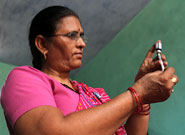
Sarita Priya is very busy carrying out another immunization session. There is a queue of people outside with their young children and she is methodically taking details in the register, before giving each child their injection. In every case the injection is given subcutaneously into the upper arm, 0.5 ml from a multidose vial, using a single-use (auto disable) syringe and the syringe is disposed into a safety box. You also see her make a note on the side of each vial, indicating the time when it was reconstituted.
Sarita also takes some time to explain to the parents exactly what she is doing, and why it will help to protect their children. For children requiring measles vaccine, she also checks whether their child previously had a measles immunization. If not, she advises them on the timing of the next, second injection and that they may not be fully protected, until and unless they do so.
The delivery of the vaccine appears to be fully in accordance with the manufacturer’s recommendation. i.e. 0.5 ml, subcutaneous, for children aged over 9 months.
Sarita is unable to break away for long, because of the queue. However she steps aside to talk with you privately for two minutes.
She says:
"Did you check out all the details of Martha in the register? We have not had any other problems, and no one else has come back to the clinic. However, there is some concern among the parents about the vaccine, because I have heard them talking to each other in the line. I think some of them know Mrs Chidawayo, and she must have spoken to them. And another thing… quite a few of them have been picking up those leaflets about the measles epidemic and why we are having a vaccination programme – more than usual."
After this she returns to continue the immunization session.
- This action is relevant.
Visiting the immunizing staff is a good opportunity to observe the health worker’s work process and handling of the vaccine. The leaflets help to meet information needs of patients and are backed by additional explanations by the health worker.

Inspect the site where the immunization session occurred.
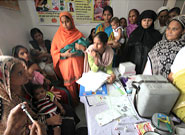
You decide to follow up to your conversation with Sarita by checking the site where the immunization took place.
The site is a small, clean room attached to the health centre, with two chairs, a table and a fridge. There are stocks of single-use (auto-disable) syringes and boxes of diluent in a cupboard above the fridge. The day's session has just finished and everything has been tidied away. There is a safety box for used syringes and ampoules are disposed of appropriately.
The ice-lined refrigerator is functional and contains no other drugs than vaccines. Its contents are cold – the thermometer reads +4 ºC. Inside the refrigerator there are stocks of Klinigen measles vaccine, from two different batches. The older batch (T-7104) contains only four ampoules, but they are all intact; the expiry date is August 2012. There are large cardboard boxes of the newer batch of vaccine (U-5773), with one box currently open; it has an expiry date of October 2012.
On a shelf you find some Easydil from Klinigen, which is currently in use. The diluent is clearly labelled for use with the vaccine. There is also a small pack of ampoules of adrenalin, which have not been opened.
- This action is relevant.
Inspecting the site where the immunization session occurred may provide you with information on how the clinic is run and how and which information is recorded. - In this case, the site appears to be well run, with clear recordsand vaccine properly stored and used with the correct diluent a provided by the manufacturer.
- The name of the manufacturer and batch numbers of the vaccine and diluent are important information to be recorded during the investigation.
On top of the fridge is an immunization register book, which shows that the Klinigen MMR vaccine batch number U-5773 and the diluent Easydil batch number SR-2781 has been used since 15 March. The register has records of all the vaccinations that have been given since 24 February 2012, and it is fully up to date. In the six immunization sessions that have taken place in the preceding week, approximately 127 children have been immunized with the Klinigen measles vaccine, and there are three entries under the name "Chidawayo".
- 4 April Jaya Chidawayo (Immunization ID number: K-HUM-1188)
72 Acacia Avenue, Karoom. Tel +049346 34 9098. - 4 April Martha Chidawayo (K-HUM-1219)
18 Woodvale, Karoom. Tel. +049346 22 1100. - 4 April Abdul Chidawayo (K-HUM-1236)
3 Corona Street, Karoom. Tel. +049346 21 5323.
All three children have been given the measles vaccine.
- Note down the specific details of the affected child, the unique immunization identification number. You should also find out the age of the child.

Send ampoules of the vaccine and diluent to the bacteriology laboratory at Karoom Hospital.
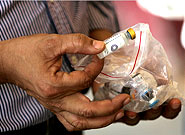
You locate 4 unopened multidose vials of the measles vaccine and diluent from the batch, which is in current use in the immunization clinic. You pick up 10 vaccine and 10 diluent vials after confirming their batch numbers. You maintain the cold chain and take them along with some partly-used vials from the clinic earlier in the day. You take them back to the bacteriology laboratory at Karoom Hospital, and give them to the head of the laboratory. 10 sets of unused AD syringes and needles are also collected by you from the centre.
He says:
"What am I supposed to do with these? The vial that was opened is certain to contain some bacteria, and it is not the same one as they were using earlier in the week. It won’t tell us anything. I could check out the unopened vial to see if it has some bacterial contamination, but we are not really set up to do this kind of test and I would not know what we are looking for."
- Considering the information available at this stage, there is no need to go for such analysis yet.
- In general, the analysis of the contents of the unopened vial can give useful information, on whether this batch of vaccine is contaminated in some way and the potency. The contents of the specific opened and used vial can provide useful information in case one suspects that the diluent used was incorrect e.g., insulin or anesthetic agent).
- Before removing vials from the clinic, you should check that you are the responsible person authorized This may vary between countries, and depend on the local AEFI reporting and investigation system. Should an analysis be indicated, note that a local laboratory is also not the place to carry out such an analysis. A reference laboratory or the vaccine manufacturer may need these vials, so set them aside for now.

Go to the paediatric clinic at Karoom Hospital to see Mrs Chidawayo and her daughter.
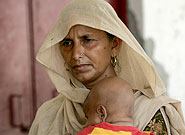
Dr John Charman is the senior paediatrician at Karoom Hospital. He has arranged to examine Martha Chidawayo at 11:00. Martha is brought in by her mother, and Dr Charman introduces you before taking a medical history.
Martha Chidawayo appears to be a healthy girl aged 2 years and 10months old – she was born on 14 June 2009. She has had no serious illnesses, other than occasional childhood infections. She received an initial course of vaccinations (DTP, IPV, Hib) at 3 months old (15 September 2009, 09:00) and was then immunized against measles (MMR) at 10 months old (16 April 2010, 11:00). She received a second measles immunization on 4 April 2012. All vaccinations took place at the Chandra Medical Centre. She has not had any previous problems following immunization, neither any other significant incidences in her medical history. You note down that no previous reactions to immunization have occurred.
Mrs Chidawayo explains that Martha was drowsy 13:00 in the afternoon following the immunization. By the evening she was starting to twitch and had a high fever. They bathed her and tried to give her paracetamol, but she had convulsions involving her whole body all of Friday night. By the middle of Saturday morning, she was starting to recover, and the fever was less, although she was restless for all of the day. By Sunday, she was much better and had started to eat normally. She now appears to be well.
Dr Charman examines Martha and observes that she is currently afebrile and has no skin rashes. Her tongue and throat are normal. He finds no significantly enlarged lymph nodes, the injection site on the upper arm has nothing significant. He takes her temperature and conducts a short neurological investigation – they are both normal. He asks about other symptoms, that could be related to parasitic and infectious diseases, prevalent in the area, but Mrs Chidawayo says that her daughter has not been ill, and has been eating normally all year.
Dr Charman decides that he should take a urine and a blood sample, requests a full blood count and peripheral smear. He considers whether he should try to take a cerebrospinal fluid sample, but decides that the risk outweighs the possible benefit, since Martha appears to have recovered. He asks that Martha should be brought back to see him at his clinic, if the symptoms return at any time.
- This is an effective step to receive more information on the adverse event and assess its outcome.
- This history gives a description of the symptoms, confirms the time of onset in relation to the immunization and gives the duration. When filling out the reporting sheet you should stick to a concise description of the event, if possible, using the standard case definitions by the Brighton collaboration91. Refrain from jumping to conclusions and entering an assumed medical diagnosis in the reporting form.

Contact Karoom hospital to see if there have been any recent admissions for seizures.
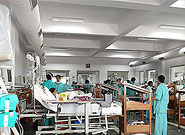
You contact the admissions desk at Karoom Hospital. They check their records. No child has been admitted within the previous 5 days with seizures.
- This activity is not of high priority.
You would expect the hospital to contact you if they had any concerns about conditions that might be related to immunization, as this is part of your job. It is important that you ensure that such lines of communication are in place before an event occurs.

Arrange for a blood sample from Martha Chidawayo to be examined.
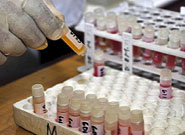
You contact the Laboratory at Karoom Hospital and requesting the report of the blood sample from Martha Chidawayo to be delivered to you as soon as possible.
You explain the circumstances and say that you are concerned about possible infection or immunodeficiency, since this will help to establish whether the seizures are related to the immunization or to other causes.
The head of the laboratory promises to look out for the sample and to deal with it as soon as it arrives.
- This action is relevant.
You, the medical centre and the hospital are in the best position to examine and investigate what has happened to Martha. These tests are within the capability of the hospital laboratory so they should be done as soon as possible.

Check the medical records of Martha Chidawayo.
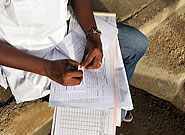
The only records that you can find for Martha Chidawayo are related to her birth on 14 June 2009 in Karoom Maternity unit, which was uncomplicated. There is also a record of her receiving a set of EPI immunizations at age 3 months at Chandra Medical Centre. She also attended an immunization clinic in April 2010 (MMR). There are no records of any admissions to hospital or other visits to the medical centre.
- This information has been already revealed by the mother of Martha. Depending on the situation it may be relevant to double check the medical records. The records indicate that Martha has been healthy since birth and they confirm what her mother has told you.

